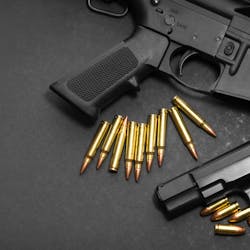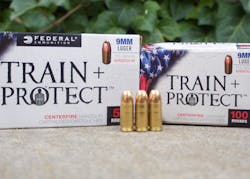7 Factors of Law Enforcement Ammunition Selection
In the U.S., there are vast differences in the sizes of law enforcement agencies. There are small ones that may consist of a sheriff and a few deputies, and then there are huge agencies whose officer population rivals the size of small cities.
When it comes to selecting ammunition, however, agencies have more things in common than one may think. For example, the steps usually follow this sequence, more or less:
- The agency makes a decision to procure new ammunition. This can be prompted by a change in the status of the provider or a changing need of the agency, etc.
- Ammunition specifications are designed or modified.
- The agency conducts testing.
- The agency opens an Invitation for Bid (IFB).
- Purchases are completed.
- The cycle begins again, either after a specified period, or as needed.
Ammunition purchases for a municipal or county government can be different from others, simply because they are generally sole source procurements once the contract is established. This means the relationship between the distributor and the agency becomes established over time. This is important because the range master may have to order ammunition incrementally, and frequently.
I have yet to talk to an agency range master who consistently has a sufficient amount of ammo and range time to keep officers sufficiently trained. Unfortunately, everyone I ever ask has an established minimum standard and rarely is allowed to exceed the minimum amount of training.
1. Consider your policies
Your agency should undergo a policy review before purchasing new ammunition. Does your agency use one brand for all calibers and applications? Does the policy cover off-duty ammo use and off-duty procedures?
If the agency requires a specific ammunition for on- and off-duty, then it would be a good idea to address the training and practice policy of the agency. “Carrying it” and “practicing with it” need to go hand in hand.
The policy can and should reflect a regular qualification and training schedule with the off-duty/backup firearm. The accompanying procedure (not policy) could reflect shooting the ammunition in the off-duty/backup gun at regular intervals, thus replenishing with new ammo.
Firearm use also has to be addressed in policy before ammo selection can be implemented. For example, an agency that has a policy allowing officers to fire at a vehicle definitely needs to know how cartridges perform against vehicle parts and components.
If we look at some of the largest agencies that actually test bullets, we can see that they generally follow the same testing scheme, commonly known as the FBI Ammunition Test Protocol. Some use an abbreviated standard, but the FBI Protocol is the recognized predictor of performance.
2. Identify your agency’s needs
This needs assessment requires an honest look at the general response of the particular agency. That is, are most incidents, especially critical incidents, involving vehicles, houses or the open air?
Consider agencies who potentially may compose a mutual aid response. The purpose here is not just to drive down the price of ammo, it may be an issue in a critical incident.
There are some factors unique to certain regions. For example, if an officer occasionally has to dispatch an animal within the community needs and policy, a particular caliber may be required. I’ve never had to patrol where alligators frequent the roadways, but I believe I would carry a premium sized cartridge for one, as necessary.
Environmental factors often will dictate agency needs. Most modern cartridges are robust enough for marine use, but some are certainly more than others.
3. Understand the complete inventory of the agency
Some agencies have separate policies, and even separate inventories, for different applications. For example, the SWAT locker of many agencies is completely separate from the armory inventory of the patrol administration. In some cases, there is very little overlap. What if the long guns of one component have different specs than the other?
If we are talking about carbines, the rate of twist in 5.56 or .223 can vary between 1/7 all the way up to 1/12. Although there are cartridges that can span these differences, their behavior is completely different than ones designed specifically for an application. If an agency has a variance that goes from 1/7-1/12 in their (5.56) carbines, it completely precludes heavier bullets, which will completely change overall capabilities.
This difference is important when agencies use pistol caliber carbines. Sub-gun bullets tend toward higher velocities when fired through slightly longer barrels. However, there is a “sweet spot” for different barrel lengths, and they take different ammunition characteristics. That is, a bullet that will perform well in after barrier tests in a handgun may shed its jacket or over-penetrate in a sub gun.
It’s a good idea to know the nominal cartridge selection for the style of firearm in which one is using. For example, if all other things are equal, lightweight, short barreled handguns do better with lighter bullets. If my agency used the Beretta 92 for duty, bullet weights would be around the 124 to 147 range. If the back up is the Beretta Nano, 115 grains.
4. Review the current data
Preparing for this article, I asked a few friends about some of their recommendations on selecting ammo for an agency. If I need good information, I always ask my friend Sergeant Erick Gelhaus of the Sonoma County, Calif., Sheriff’s Office. Besides providing many of the recommendations here, he emphasized critically reviewing the data. Early in our conversation, he asked, “How many agencies even test ammo on the range before buying?” Gee, I really, really hope every agency does.
There are plenty of ballistics myths that are perpetuated by legend. If an agency is going to select something that works, one must critically review competent sources of data. Foremost, it is wise to request data from the FBI BRF (Ballistics Research Facility) for specific data on specific tools. It’s going to take some work to wade through the data. The FBI Defensive Systems Unit is constantly testing, a practice from which we all benefit. Getting a hold of this data will require an official request to view some of the more important material, so get out the letterhead.
Agency representatives should attend manufacturer’s demonstrations of the capabilities of their ammunition. Bear in mind that demonstrations are not actual tests, but it will give everyone an opportunity to view the ammunition use and ask questions.
I get to look at plenty of cartridges in the course of my work. When I test a handgun cartridge, the first test I do is the eliminator. The cartridge needs to feed and fire reliably in the duty handgun. If it does not, move on without looking back.
Handgun cartridges for duty should penetrate calibrated ballistic gelatin between 12 to 18 inches. Less than 12 inches means that the bullet will not travel far enough to reach vital organs, causing the threat to discontinue the current course of action. Greater than 18 inches means that the bullet could potentially leave the confines of the threat and strike an unintended target. There are other tests that determine effectiveness, but I start with these.
Just because the cartridge can perform the first test, does not mean it will excel on others. I have had bullets perform admirably in bare gelatin, then barely penetrate the barrier. Worse, I have had bullets over-penetrate after barrier because debris impacts the hollow point and the otherwise expanding bullet becomes a buried missile.
Velocity and weight are not necessarily predictors of good performance, but they are certainly factors. The ideal duty cartridge, when fired, sends a bullet with sufficient energy to the target that can be transferred to the target. This is not a science lesson and I am not a scientist. However, bullets must travel a certain velocity in order for them to expand. Ideally, they transfer energy to the target during the rapid expansion and deceleration of the bullet. This energy transfer is also affected by the caliber, weight and design of the bullet.
Finally, if the cartridge does not produce reasonable accuracy, it defeats the purpose.
There are other factors besides ballistic performance that will affect the cartridge selection decision, depending on the priorities of the agency. These factors can only come from input from the range staff. For example, if the cartridge makes the duty guns dirty after only a little practice, or the bullet deforms after a little bit of handling, I would seek input from the agency armorer.
5. Shoot the cartridges yourself
When I test ammunition for an article, invariably I will add a disclaimer. Ammunition companies are very good at sending me test rounds, but I only shoot a percentage of rounds, compared to the number that need to go downrange for agency adoption. Shoot thousands, not dozens.
This used to be quite complicated. A few years back, I would order vast amounts of gelatin powder. I had an entire set up in my garage. I would heat water to a specific temperature, then stir while a “volunteer” would pour the gelatin in a little at a time. I would spend a lot of effort maintaining temperature.
I use Clear Ballistics Gelatin now. I don’t have to drag a truckload of coolers to the range and the smell of rendered gelatin no longer permeates my house every couple of weeks.
6. Consider the politics of the agency
Yes, it is offensive to consider politics when it comes to selecting something that has to do with officer safety. However, this step could prevent considerable heartache later. When we say “politics” we have to temper the term a little. Do some research about the company with which you are about to do business. If your agency has a “Berry Amendment type” of consideration, this will preclude some product manufacturers. Most larger manufacturers will have their production in the U.S., however.
There are other local politics. What if the company you are considering is somehow affiliated with a company who pulled all their operations out of your state recently? Would the public perception of your selection be a factor here?
Research this aspect carefully. Some “foreign” manufacturers, like Armscor, have continued to move manufacturing processes to the U.S. in recent expansions. I’m certain that both Nevada and Montana appreciate the investment in the local economy. I do, because I shoot their ammo all the time.
One of the considerations our agency made was the fact that there was a statewide contract on a particular brand of ammo. It wasn’t our first choice, but it ranked right up there, and met the ballistic needs. Because of the state contract, a premium product was noticeably cheaper. That sealed the deal for us.
7. Shoot at night
I was testing a cartridge one time that absolutely excelled in standard tests. Then our team waited until dusk, fired the first round, then had to stop. The propellant produced such a bright flash, we were temporarily blinded. I was very surprised, given the quality of the cartridge.
This particular factor is critical, not only for officers working the night shift, but simply for anyone who might potentially go indoors for building search. This means everyone, by the way.
Ammo selection is a team sport. Make sure your team gets all of the players involved.
About the Author

Officer Lindsey Bertomen (ret.), Contributing Editor
Lindsey Bertomen is a retired police officer and retired military small arms trainer. He teaches criminal justice at Hartnell College in Salinas, California, where serves as a POST administrator and firearms instructor. He also teaches civilian firearms classes, enjoys fly fishing, martial arts, and mountain biking. His articles have appeared in print and online for over two decades.



